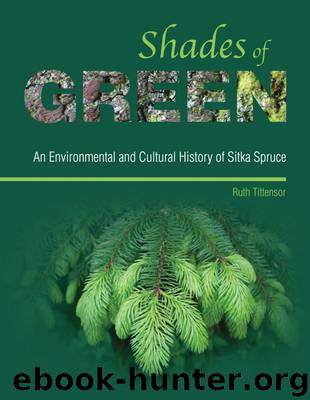Shades of Green by Tittensor Ruth;

Author:Tittensor, Ruth;
Language: eng
Format: epub
Publisher: Windgather Press
Published: 2017-01-01T16:00:00+00:00
MAP 15. Commercial Sitka spruce in Europe, prepared by Susan Anderson.
DATA COURTESY OF BILL MASON
In the Faroe Islands native woodlands of Betula pubescens, rowan, aspen and juniper have been gone for more than a thousand years, helped by sheep, strong sea-winds and cool summers. Sitka spruce, Lodgepole pine and several Southern beech (Nothofagus species) have grown well in small, modern plantations.
FIGURE 11.9. Wartime fellings in Allerston Forest, North Yorkshire 1939.
PHOTO: COURTESY FORESTRY COMMISSION. © CROWN COPYRIGHT.
Scandinavia still has indigenous forests, but afforestation was important to supply its big timber industry during the twentieth century. In Norway and Denmark, with their westerly coasts, Sitka spruce has formed satisfactory plantations. In continental Germany and Holland, Sitka spruce was planted on a small scale as a timber tree and for ornament.
Map 15 shows the European countries which grow Sitka spruce commercially.
The Second World War
It has been calculated that annual imports of timber to Britain were reduced from 9.5 to 1.78 million tonnes (10.5–1.96 million tons) during the War, due to reduced purchases and sinking of transatlantic merchant shipping by submarines. A recent study of wartime records showed that: ‘No other raw material of magnitude shows anything like the same fall in imports, nor indeed was any bulk material replaced by home production to the same degree as timber.’ (Weir 2003)
There was no alternative but to use home-grown timber for pit props, bridges, military buildings and furniture, mulberry harbours and domestic needs.
By 1939, the Forestry Commission had acquired 584,367 ha (1,444,000 acres) of plantable land of which 175,634 ha (434,000 acres) had been afforested. However – the trees were not yet ready to harvest – the ‘Strategic Reserve’ had been growing for less than twenty years.
The volume of available timber nationally was less in 1939 than in 1914 because there had been so little incentive for private landowners to invest in forests.
What could be done? The same as before…
The owners of private forests were asked to sacrifice their woodlands once more especially in Scotland where cover of mature woodland was greatest:
Download
This site does not store any files on its server. We only index and link to content provided by other sites. Please contact the content providers to delete copyright contents if any and email us, we'll remove relevant links or contents immediately.
Turbulence by E. J. Noyes(7700)
The Thirst by Nesbo Jo(6435)
Gerald's Game by Stephen King(4372)
Be in a Treehouse by Pete Nelson(3646)
Marijuana Grower's Handbook by Ed Rosenthal(3509)
The Sprouting Book by Ann Wigmore(3408)
The Red Files by Lee Winter(3281)
The Remains of the Day by Kazuo Ishiguro(3134)
Sharp Objects: A Novel by Gillian Flynn(2845)
Christian (The Protectors Book 1) by L. Ann Marie(2600)
Organic Mushroom Farming and Mycoremediation by Tradd Cotter(2563)
The Culinary Herbal by Susan Belsinger(2331)
Stone Building by Kevin Gardner(2289)
Lilac Girls by Martha Hall Kelly(2193)
The Starter Garden Handbook by Alice Mary Alvrez(2193)
The Unlikely Pilgrimage of Harold Fry by Rachel Joyce(2130)
The Lean Farm Guide to Growing Vegetables: More In-Depth Lean Techniques for Efficient Organic Production by Ben Hartman(2010)
Urban Farming by Thomas Fox(1982)
Backyard Woodland by Josh VanBrakle(1828)
